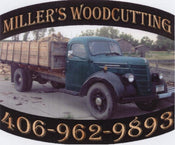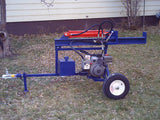What to Know About Log Splitters
Purchase Firewood Processor Plans
Log Splitters: What you need to know
When making a hydraulic log splitter there are a number of things to consider.
1. Size and hardness of the wood you intend to split
There are numerous species of wood across the country that are used for firewood. Wood can vary a great deal in how hard it is to split. The strength of your splitter is important, but not the only factor. Many people end up paying a lot for a much larger splitter than is necessary. View our page on "tips for splitting firewood".
2. Hydraulic force necessary to split the wood. Do you really need a 30 ton splitter?
The capacity of a hydraulic splitter is based on a combination of the pump flow volume, the pressure created by the restrictions in the system (valve hole, cylinder resistance etc), and the cylinder diameter. Put simply it is Cylinder area multiplied by system pressure.
For a common example: A 2500 PSI system using a 3 1/2 inch cylinder.
Force = 2500 * (3.0625 * 3.14) Force = PSI (R squared * Pi)
Force = 24,040 or 12 ton of splitting force.
So how do you get a 30 ton splitter? High pressures and larger cylinders (4 inch is common). You will find though that the metal required to hold that much force together in a usable fashion.....makes for an expensive homemade splitter.
3. What is Cycle Time?
Cycle time refers to how fast the cylinder goes out and returns. Fast cycle times make for faster production. Fast cycle times also make for more dangerous working conditions. It is easier to have accidents so be careful about getting a cyle time that is hard to safely work around.
Cycle times are based upon how fast the fluid can fill the cylinder. Cycle times for wood splitters are a combination of the volume capacity in gallons per minute of the system pump and the volume of the extended cylinder (diameter and length).
Fast cycle times are made from either smaller diameter and shorter cylinders or from larger pumps. Small cylinders are cheaper than large cylinders, while the cost of a pump goes up with larger GPM ratings.
4. Horizontal or Vertical splitting?
Most splitters are set up for horizontal splitting. When working this way you want the beam to be waist high. Waist high allows you to work at a height that doesn't require stooping and extra back ache. The down side of a waist high work area is that all of the rounds have to be raised to that level.
Splitters than can tilt and be used in a vertical position are very handy for large, heavy pieces that are difficult to put on a waist high splitting beam.
5. Engine Size
Approx. 1/3rd of the price of a wood splitter is in the gas engine used as the prime source of power. Having an engine with extra horsepower sounds impressive but really that is just extra expense. Once an engine provides enough power to keep the pump operating at rate pressure (PSI) and flow (GPM) without allowing the engine to bog down there is no use or need for increased horsepower.
The availability of inexpensive off-brand small gas engines and used engines from other applications has made making your own splitter a very cost effective option.
Roughly the hydraulic system needs 3/4 Horsepower per GPM of pump rating. For example a 8gpm system will work adequately on 6 HP, a 16gpm system will work on 12. Use of 1 HP per GPM is about the most that is necessary. HP to GPM ratios higher than this are just using extra fuel for no real extra return in efficiency.
6. Beam Strength
Beams, cylinder mounts, and the stop foot (end the wedge pushes agains) for working forces over 18 ton require much heavier metal and deeper welds. Splitters of this force are not generally a good idea for the home built splitter.
7. Overall Weight and Transporting of the Splitter.
When building your splitter don't forget that you will need to move it. Towing the splitter is easy and common. Keep in mind that you will still need to move it my hand in order to hook it to the towing vehicle and to adjust its location when in use. The added weight of heavier steel, higher capacity hyrdaulic components and larger engines all accumulate quickly. Don't make a splitter that is good to use, but horrible to move.
8. Working comfort for the operator.
One of the biggest benefits of making your own splitter is that you can make it to fit you. Your splitter can be customized for your comfortable working height, desired wood length, etc. Do you want a 4 way wedge, or to push the splitting foot and have the wedge on the end of the rail? If so you can make the splitter to your desired end use.
9. Plans, do I need them?
The benefit of using plans for your splitter is that the details will already be worked out. Even if you desire to modify the plans to customize the end product you will be able to see (not just visualize and imagine) what has already been done. Plans save time in design and fabrication. The real question isn't "do you need plans", but "what's your time worth?"


